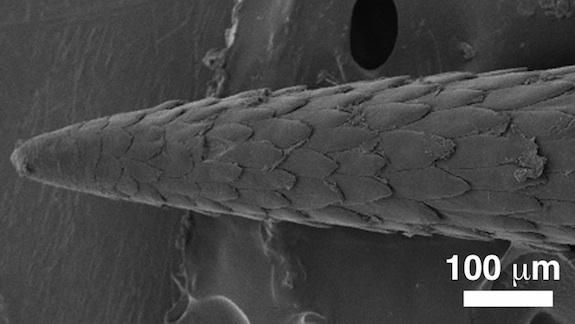Could Porcupine Quills Help Us Design the Next Hypodermic Needle?
Microscopic barbs allow porcupine quills to slice into flesh easily and stay there stubbornly—qualities that could prove useful in medical applications
/https://tf-cmsv2-smithsonianmag-media.s3.amazonaws.com/filer/Surprising-Science-Porcupine-631.jpg)
If you’ve ever had a violent encounter with a porcupine, it probably didn’t end well. The large rodents are most well-known for the coat of some 30,000 barbed quills that cover their backs, an evolutionary adaptation to protect against predators. Although they appear thin—even flimsy—once quills lodge in your flesh, they’re remarkably difficult and painful to get out.
Recently, a group of scientists led by Jeffrey Karp of Harvard decided to closely investigate just what makes these quills so effective. As they report in an article published today in the Proceedings of the National Academy of Sciences, their analysis revealed a specialized microscopic barbed structure that enables the quills to slide into tissue extremely easily but cling to it stubbornly once it’s in place.

Each cylindrical quill, it turns out, is coated with backwards-facing barbs interspersed with smooth, scale-like structures. When a porcupine brushes up against an adversary (or against anything else), it sheds its quills; the barbs around the circumference of the quill act like the teeth on a slicing serrated knife, providing a cleaner cut into tissue and making penetration easier. Once the quill has dug into the other animal, these same barbs have the opposite effect, lifting up and preventing the needle from sliding out easily.
The researchers took a rather interesting approach to arrive at these findings: They measured how much force it took to push in and pull out porcupine quills into pig skin and raw chicken meat. They then performed the same experiment with other quills, which they’d rendered smooth by carefully sanding off all the barbs.
All this research had a greater purpose than merely satisfying the authors’ curiosity about porcupines. Like velcro (inspired by plants’ burrs that get stuck on your clothing) and tape-based adhesives (inspired by the sticky coating on geckos’ hands and feet), the scientists studied the characteristics that made the barbs so effective in hopes of developing next-generation hypodermic needles.
If one could be designed that would require less force to penetrate human tissue, it might mean less pain with your next flu shot. The quills’ staying power could be useful for needles that need to stay in place for a longer period of time, like an I.V. drip.
As a proof-of-principle, the team made replica porcupine quills made out of plastic and put them through the same battery of tests on tissue and skin. The plastic quills worked like a charm. The researchers speculate that such technology could someday be incorporated into a range of medical applications beyond hypodermic needles, such as staples that hold wounds together during healing and adhesives used to hold drug delivery systems in place.
/https://tf-cmsv2-smithsonianmag-media.s3.amazonaws.com/accounts/headshot/joseph-stromberg-240.jpg)
/https://tf-cmsv2-smithsonianmag-media.s3.amazonaws.com/accounts/headshot/joseph-stromberg-240.jpg)